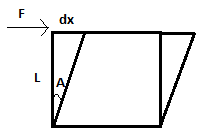This set of Class 11 Physics Chapter 9 Multiple Choice Questions & Answers (MCQs) focuses on “Solids Mechanical Properties – Elastic Moduli”.
1. Which of the following quantities have the same S.I. unit as that of modulus of elasticity?
a) Energy per unit volume
b) Force per unit length
c) Energy
d) Change in length
View Answer
Explanation: Modulus of elasticity is the ratio of stress to strain. Its unit is, therefore, N/m2. Energy per unit volume has the unit Nm/m3 = N/m2. Force per unit length has the unit N/m. So, the correct answer is energy per unit volume.
2. A small body having mass 1kg is rotating in a circle of radius 10cm. It is connected to the centre with the help of a string having young’s modulus = 1011N/m2. Find change in length of wire while the mass is rotating with constant speed of 2m/s. The cross sectional area of string is 1cm2.
a) 0.4μm
b) 4μm
c) 40μm
d) 0.4m
View Answer
Explanation: Tension ‘T’ in string will be given by T = mv2/R = 1*4/0.1 = 40N.
Stress = Y*Strain, where Y is young’s modulus. T/A=Y*ΔL/L
∴ ΔL = TL/AY = (40*0.1)/(0.0001*1011)
= 4*10-7m = 0.4μm.
3. Which of the following represents volumetric strain?
a) -ΔV/V
b) ΔV/V
c) Pressure/Volume
d) -P / (ΔV/V)
View Answer
Explanation: The volumetric strain is defined as ratio of change in volume to original volume. It can be either positive or negative. The option -P / (ΔV/V) is the bulk modulus which is basically the ratio of volumetric stress to volumetric strain.
4. Bulk modulus is defined as -P / (ΔV/V). Therefore it can be negative. True or False?
a) True
b) False
View Answer
Explanation: Bulk modulus is defined as the ratio of volumetric stress to volumetric strain. And volumetric stress is force applied per unit area which is pressure. Now, when pressure is applied on a body its volume decreases, therefore a minus sign is used to make bulk modulus positive. Hence, it is positive.
5. A 10N force is uniformly distributed over the surface of a sphere of radius 20cm. The force at each point acts inward along the normal at that point. Find the fractional change in volume if the compressibility of the sphere is 10-11m2/N.
a) 3*10-10
b) 1.5*10-11
c) 1.98*10-10
d) 2*10-11
View Answer
Explanation: Bulk Modulus ‘B’ is defined as -P / (ΔV/V). And B is the reciprocal of compressibility.
∴ B = 1/10-11= 1011N/m2.
ΔV/V = P/B.
P = 10/(4π*0.04)
∴ ΔV/V = -P/B = – 10/(4π*0.04*1011) = 1.98*10-10.
6. Select the correct option. B is bulk modulus.
a) Bgas > Bliquid > Bsolid
b) Bliquid > Bgas> Bsolid
c) Bsolid > Bliquid > Bgas
d) Bliquid > Bgas > Bsolid
View Answer
Explanation: Bulk modulus is the inverse of compressibility. Solids are the least compressible, followed by liquids and then gases being the most compressible. Thus solids have the maximum B, and liquids the least.
7. A lake has a depth of 500m. The bulk modulus of water is 2*109N/m2. Calculate the fractional compression, ΔV/V, of water at the bottom of the lake.
a) 2.5*10-3
b) 7*10-3
c) 3.5*10-3
d) 5*10-3
View Answer
Explanation: Pressure at the bottom ‘P’ = ρgh = 1000*10*500 = 5*106Pa.
B = -P/(ΔV/V)
∴ ΔV/V = -P/B = 5*106/2*109 = 2.5*10-3.
8. The shear force applied has a magnitude of 1N. The box given below was initially a cube of 50cm side. Find the value of A *1010. Shear Modulus ‘G’ = 1010N/m2.

a) 4 radians
b) 4 degrees
c) 2 radians
d) 2 degrees
View Answer
Explanation: G = (F/Area) / (dx/L) = (F/Area) / A (∵ A = dx/L)
⇒ A = F/(G*Area) = 1 / (1010*0.5*0.5) = 4*10-10rad
∴ A*1010 = 4 radians.
9. Which of the following stresses causes change in density, as long as force acts on the body?
a) Shear stress
b) Compressive Stress
c) Tensile stress
d) Volumetric stress
View Answer
Explanation: Volumetric stress is due to forces applied on the surface of a body from all directions such force is along normal at each point. This causes a change in volume while mass, obviously, remains the same. So, there is a slight change in density. Note that it is negligible but this change of density doesn’t occur in any other type of stresses, as the change in longitudinal length is compensated by change in lateral length in case of longitudinal stresses.
10. A wire has a cross sectional area ‘A’, length ‘L’ and young’s modulus ‘Y’. It is pulled by a force ‘F’ which causes a total extension of length ‘l’. The force F is so adjusted that the wire is only slowly stretched. Find the work done by the force in pulling the string by a length ‘dx’ when extension is x (0 > x > l).
a) ½*stress*strain*volume
b) (AY/L)xdx
c) F*l
d) ½*stress * strain
View Answer
Explanation: The force F at any instant will be equal to internal force developed as the wire is to be slowly stretched.
∴ F=(AY/L)x
∴ Work done for dx extension = F*dx = (AY/L)xdx.
Sanfoundry Global Education & Learning Series – Physics – Class 11.
To practice all chapters and topics of class 11 Physics, here is complete set of 1000+ Multiple Choice Questions and Answers.
If you find a mistake in question / option / answer, kindly take a screenshot and email to [email protected]
- Check Class 11 - Physics Books
- Practice Class 11 - Chemistry MCQs
- Practice Class 11 - Biology MCQs
- Practice Class 12 - Physics MCQs
- Practice Class 11 - Mathematics MCQs
